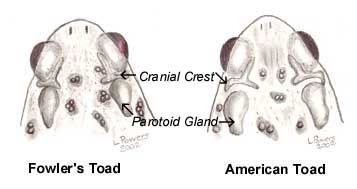Still believing I was a predator, the toad hopped a short distance away. I followed.
I had some difficulty in identifying this toad. It could belong to one of 3 species: the Eastern American Toad, (Bufo americanus americanus, or Anaxyrus a.a.), Fowler's Toad (Bufo fowleri, or Anaxyrus f.), or the Southern Toad (Bufo terrestris, or Anaxyrus t.). Now, it seems to me that the main distinguishing characteristics of toads are the shape and position of the cranial crests and paratoid glands, as well as the frequency of warts on the back and the presence of spots on the belly.
 |
| http://wwknapp.home.mindspring.com/docs/american.toad.html |
 |
| http://www.frogforum.net/toads/8997-few-toadlet-pics.html |
Thus, the description of the Eastern American Toad seems to correspond most closely with what I observed in my toad. However, there's always the possibility that it could be of a different species, even a hybrid, as the ranges of the American Toad and Fowler's Toad overlap. So, don't hesitate to correct me if I've wrongly identified this toad. I'm more interested in getting the ID right than being right myself. Also, let me know if you know the sex of this toad.
This is a good site about frogs and toads, specific to my state of South Carolina:
http://www.snakesandfrogs.com/scra/frogs/scfrog.htm
Here's one pertaining to North Carolina:
http://www.herpsofnc.org/herps_of_NC/anurans/Bufame/Buf_ame.html
I also consulted these sites:
http://www.npwrc.usgs.gov/resource/herps/amphibid/species/american.htm
http://www.npwrc.usgs.gov/resource/herps/amphibid/species/bfowl.htm
http://www.npwrc.usgs.gov/resource/herps/amphibid/species/bterrest.htm
http://www.enature.com/fieldguides/detail.asp?recNum=AR0006
http://animaldiversity.ummz.umich.edu/site/accounts/information/Bufo_americanus.html
http://amphibiaweb.org/cgi/amphib_query?where-genus=Anaxyrus&where-species=americanus

























No comments:
Post a Comment